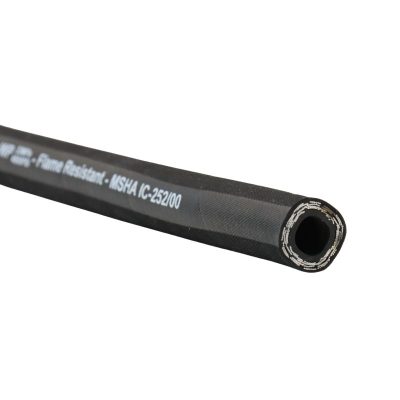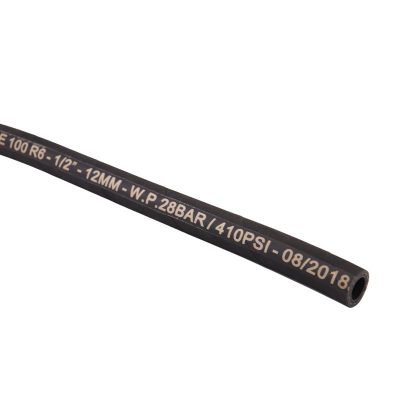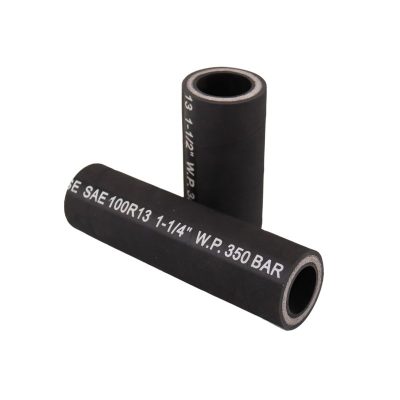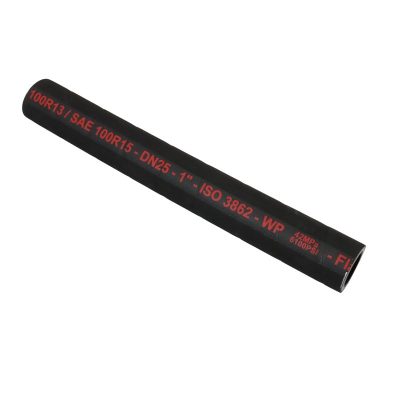In the realm of hydraulic systems, adhering to hose standards is crucial for ensuring safety and operational efficiency. This comprehensive post delves into the world of hydraulic hose standards, shedding light on their significance and offering key insights and guidelines. You’ll learn about the most important standards, such as SAE and EN, and how they impact the selection, maintenance, and overall performance of hydraulic hoses. The content will also explore the similarities and differences between these standards, and provide practical advice for choosing the right hose and maintaining it properly.
Hydraulic hose standards play a pivotal role in ensuring the safety and reliability of hydraulic systems. These standards are designed to specify the materials, construction, and performance criteria for hoses, which helps prevent failures that could lead to accidents or system malfunctions. By adhering to these standards, manufacturers and users can trust that the hoses will perform consistently under specified conditions, reducing the risk of leaks, bursts, and other hazardous failures. This ensures that the hydraulic systems operate safely and efficiently, protecting both equipment and personnel.
Standards are essential for maintaining industry compliance, as they provide a universally accepted benchmark for quality and performance. Regulatory bodies and industry organizations often mandate adherence to specific standards to ensure that products meet minimum safety and performance criteria. Compliance with these standards helps companies avoid legal issues and potential fines associated with non-compliance. It also facilitates easier market access, as many customers and markets require proof of compliance with recognized standards before they will do business with a manufacturer or supplier.
The Society of Automotive Engineers (SAE) is a global association of engineers and related technical experts in the aerospace, automotive, and commercial-vehicle industries. SAE develops standards that ensure quality, safety, and efficiency in these industries, including hydraulic hoses.
Structure
The SAE J517 100R1AT hydraulic hose features a robust construction with a single layer of high-tensile steel wire braid. This steel braid is embedded within layers of synthetic rubber, creating a durable and flexible structure that is ideal for various hydraulic applications. The inner tube is made from oil-resistant synthetic rubber, ensuring compatibility with a wide range of hydraulic fluids. The outer cover, also made from synthetic rubber, is engineered to resist abrasion, weather, and environmental conditions, providing additional protection and longevity.
Working Pressure
The 100R1AT / 1SN hose is designed to handle working pressures up to 225 bar, making it suitable for medium-pressure hydraulic systems. The exact working pressure can vary depending on the hose diameter, with smaller diameters generally able to withstand higher pressures.
Temperature Range
This hydraulic hose operates effectively within a wide temperature range of -40°C to +100°C. This flexibility makes it suitable for use in various climates and conditions, from cold winter environments to hot industrial settings.

Structure
The SAE J517 100R2AT / 2SN hydraulic hose features a double layer of high-tensile steel wire braid, providing enhanced strength and durability. This construction comprises an inner tube made from oil-resistant synthetic rubber, which ensures compatibility with a wide range of hydraulic fluids. The double steel wire braid reinforcement is embedded between layers of synthetic rubber, offering exceptional resistance to pressure and external impacts. The outer cover, also made from synthetic rubber, is designed to withstand abrasion, environmental factors, and weather conditions, thereby extending the hose’s service life.
Working Pressure
Designed to handle high-pressure hydraulic applications, the 100R2AT / 2SN hose can endure working pressures up to 400 bar. The precise pressure capacity varies with the hose diameter, with smaller diameters typically supporting higher pressures.
Structure
The SAE J517 100R3 hydraulic hose is constructed with a double layer of high-strength fiber braid, providing enhanced flexibility and lightweight characteristics. The inner tube is made from oil-resistant synthetic rubber, ensuring compatibility with a wide range of hydraulic fluids. The double fiber braid reinforcement is embedded within the hose, offering substantial strength and durability while maintaining excellent flexibility. The outer cover is also made from synthetic rubber.
Working Pressure
The 100R3 hose is designed to handle working pressures up to 88 bar, making it suitable for low-pressure hydraulic systems. The exact working pressure can vary depending on the hose diameter, with smaller diameters generally capable of withstanding higher pressures. This capability ensures reliable performance in applications where consistent low-pressure hydraulic oil delivery is essential.
Structure
The SAE J517 100R4 hose is built with a rubber inner tube, which is resistant to hydraulic fluids, ensuring compatibility with various types of hydraulic oil. This inner tube is encased in a layer of fiber braid, which provides flexibility and strength. Additionally, the hose is reinforced with a spiral wire layer, offering excellent resistance to collapsing and maintaining the hose’s shape under vacuum conditions.
Working Pressure
The 100R4 hose is capable of handling working pressures up to 28 bar, making it suitable for low-pressure or suction and return line applications. The specific working pressure can vary depending on the hose’s diameter, with smaller diameters typically capable of withstanding higher pressures. This capability ensures the hose can reliably perform in applications that require consistent low-pressure fluid transmission or suction.
Structure
The SAE J517 100R5 hydraulic hose is constructed with a combination of materials designed to provide durability and flexibility. The hose features an inner tube made from oil-resistant synthetic rubber, ensuring compatibility with various hydraulic fluids. This inner tube is reinforced with a single layer of high-tensile steel wire braid, which provides the hose with the strength to withstand high-pressure applications. The outer cover is made of a textile braid, offering an additional layer of protection against abrasion, environmental elements, and wear.
Working Pressure
The 100R5 hose is designed to handle working pressures up to 210 bar, making it suitable for medium to high-pressure hydraulic systems. The exact working pressure can vary depending on the hose diameter, with smaller diameters generally able to withstand higher pressures. This capability ensures reliable performance in applications where maintaining consistent hydraulic pressure is essential.

Structure
The SAE J517 100R6 hydraulic hose features a simple yet effective construction designed for low-pressure applications. It comprises an inner tube made from oil-resistant synthetic rubber, ensuring compatibility with a variety of hydraulic fluids. This inner tube is reinforced with a single layer of high-strength fiber braid, providing the necessary strength and flexibility for low-pressure hydraulic systems. The outer cover, also made from synthetic rubber, offers protection against abrasion, weather, and environmental factors, contributing to the hose’s durability and longevity.
Working Pressure
The 100R6 hose can handle working pressures up to 28 bar, making it suitable for low-pressure hydraulic systems. The specific working pressure can vary depending on the hose’s diameter.
Structure
The SAE J517 100R7 hydraulic hose is designed with advanced materials to provide excellent performance in medium-pressure applications. It features a thermoplastic inner tube that is compatible with a wide range of hydraulic fluids, ensuring fluid compatibility and system integrity. This inner tube is reinforced with a fiber braid, which enhances the hose’s strength and flexibility. The outer layer is also made from thermoplastic material.
Working Pressure
The 100R7 hose can handle working pressures up to 210 bar, making it suitable for medium-pressure hydraulic systems.
Structure
The SAE J517 100R8 hydraulic hose is constructed with advanced materials designed for high-pressure applications. It features a thermoplastic inner tube, which ensures compatibility with a wide range of hydraulic fluids. This inner tube is reinforced with a layer of high-strength fiber braid, providing significant strength and flexibility. The outer layer is also made of thermoplastic material.
Working Pressure
The 100R8 hose is capable of handling working pressures up to 350 bar, making it suitable for high-pressure hydraulic systems.
Structure
The SAE J517 100R12 hydraulic hose is designed for ultra-high-pressure applications and features a robust construction with four layers of spiral steel wire reinforcement. The inner tube is made from oil-resistant synthetic rubber, ensuring compatibility with a variety of hydraulic fluids. The four layers of high-tensile steel wire spirals provide exceptional strength and pressure resistance, making the hose suitable for extremely demanding environments. The outer cover is made from synthetic rubber.
Working Pressure
The 100R12 hose is capable of handling working pressures up to 420 bar, making it suitable for ultra-high-pressure hydraulic systems.

Structure
The SAE J517 100R13 hydraulic hose is constructed with multiple layers of high-tensile steel wire spirals, providing exceptional strength and durability for ultra-high-pressure applications. The inner tube is made from oil-resistant synthetic rubber, ensuring compatibility with a wide range of hydraulic fluids. The multiple steel wire spirals are embedded within the hose, offering outstanding pressure resistance and robustness.
Working Pressure
The 100R13 hose is capable of handling working pressures up to 500 bar, making it suitable for extremely high-pressure hydraulic systems.
Structure
The SAE J517 100R14 hydraulic hose is unique due to its construction with a PTFE (Polytetrafluoroethylene) inner tube, which offers exceptional chemical resistance and thermal stability. This inner tube is reinforced with a single or double layer of stainless steel wire braid, providing strength and flexibility. The PTFE material ensures compatibility with a wide range of hydraulic fluids and chemicals, making it ideal for specialized applications.
Working Pressure
The 100R14 hose can handle working pressures that vary widely depending on the hose diameter and construction (single or double braid), typically up to 200-400 bar. This versatility makes it suitable for medium to high-pressure hydraulic systems requiring chemical resistance and high-temperature stability.
Structure
The SAE J517 100R15 hydraulic hose is designed for ultra-high-pressure applications, featuring multiple layers of high-tensile steel wire spirals. The inner tube is made from oil-resistant synthetic rubber, ensuring compatibility with various hydraulic fluids. The multiple spiral layers provide exceptional pressure resistance, while the synthetic rubber outer cover protects against abrasion, weather, and environmental factors.
Working Pressure
The 100R15 hose can handle working pressures up to 6100 psi, making it suitable for the most demanding hydraulic systems.

Structure
The SAE J517 100R16 hydraulic hose features a single or double layer of high-tensile steel wire braid reinforcement, providing strength and flexibility. The inner tube is made from oil-resistant synthetic rubber, ensuring compatibility with a variety of hydraulic fluids. The outer cover is made from synthetic rubber.
Working Pressure
The 100R16 hose is designed to handle medium to high working pressures, typically up to 420 bar, depending on the hose diameter.
Structure
The SAE J517 100R17 hydraulic hose features a compact design with a single or double layer of high-tensile steel wire braid reinforcement. The inner tube is made from oil-resistant synthetic rubber, ensuring compatibility with a wide range of hydraulic fluids. The outer cover, made from synthetic rubber, provides robust protection against abrasion, weather, and environmental elements.
Working Pressure
The 100R17 hose can handle working pressures up to 420 bar, making it suitable for high-pressure hydraulic systems. This high-pressure capability ensures reliable performance in demanding applications requiring consistent hydraulic pressure.
European Norm (EN) standards are widely recognized in the European market and cover a broad spectrum of hydraulic hose specifications. These standards are established by the European Committee for Standardization (CEN) and ensure that hydraulic hoses meet rigorous safety, performance, and quality requirements. Adhering to EN standards is crucial for manufacturers and users in Europe, ensuring compliance with regional regulations and achieving high levels of reliability and efficiency in hydraulic systems.
Description: EN 853 specifies requirements for medium to high-pressure hydraulic hoses and hose assemblies.
Categories:
EN 853 1SN: Single-wire braided hydraulic hose for medium pressure.
EN 853 2SN: Double-wire braided hydraulic hose for high pressure.
Working Pressure: Varies depending on hose type, typically ranging from 1,000 to 5,000 psi.
Temperature Range: Generally from -40°C to +100°C, with some variations based on specific hose materials and applications.
Construction: Reinforced with one or two layers of high-tensile steel wire braid.
Applications: Suitable for hydraulic systems in construction machinery, industrial equipment, and agricultural machinery where medium to high pressure is required. These hoses are designed to handle hydraulic oils and fluids, providing reliable performance in various industrial environments.
EN 857 defines requirements for high-pressure hydraulic hoses with increased flexibility.
Categories:
EN 857 1SC: Single-wire braided hydraulic hose with compact design for high pressure.
EN 857 2SC: Double-wire braided hydraulic hose with compact design for very high pressure.
Working Pressure: Typically up to 6,000 psi, depending on hose type.
Temperature Range: Usually from -40°C to +100°C, depending on the hose material and application.
Construction: Reinforced with one or two layers of high-tensile steel wire braid, designed for increased flexibility and compactness.
Applications: Ideal for hydraulic systems requiring high pressure and enhanced flexibility. These hoses are commonly used in mobile equipment, such as forklifts and cranes, where space is limited, and flexibility is essential for efficient operation.
EN standards detail requirements for hose performance, ensuring that hydraulic hoses meet stringent European safety and performance criteria. Key requirements include:
Pressure Ratings: EN standards specify the maximum working pressure that hydraulic hoses can safely withstand. This ensures that hoses can handle the expected pressure levels in various applications without failure.
Temperature Ranges: The standards outline the acceptable temperature ranges for hose operation, ensuring that hoses can perform reliably under different temperature conditions without degradation.
Burst Pressure: EN standards define the minimum burst pressure, which is typically several times higher than the working pressure. This provides a safety margin, ensuring that hoses can withstand unexpected pressure spikes.
Construction Materials: EN standards specify the materials used for hose construction, including the type of reinforcement (e.g., steel wire braid) and the composition of the inner and outer layers. This ensures that hoses are durable, flexible, and resistant to abrasion and other environmental factors.
Performance Testing: EN standards require rigorous testing of hydraulic hoses, including pressure tests, impulse tests, and flexibility tests, to ensure they meet the specified performance criteria.
SAE Standards: Primarily used in North America and globally recognized due to the widespread influence of the automotive and aerospace industries.
EN Standards: Predominantly used in Europe and are crucial for compliance with European regulations and market demands.
SAE Standards: Often have higher pressure ratings for certain hose types, reflecting the rigorous demands of North American applications.
EN Standards: May have different pressure rating criteria that align with European application needs and safety regulations.
SAE Standards: Emphasize different testing protocols, which might include specific impulse tests, abrasion tests, and other performance evaluations tailored to North American industrial requirements.
EN Standards: Include distinct testing methods to ensure hoses meet European safety and performance criteria, often with a focus on burst pressure and flexibility.
SAE Standards: Include a broader range of hose types, often specifying different construction materials and reinforcement techniques to cater to diverse industries such as automotive, aerospace, and industrial machinery.
EN Standards: Focus on applications common in Europe, often reflecting regional industrial practices and machinery design preferences.
Adhering to hydraulic hose standards ensures safety, reliability, and optimal performance. Understanding and following key SAE and EN standards, selecting the right hose, and maintaining it properly are essential steps for any business. Stay informed about the latest standards and prioritize safety and compliance in your hydraulic systems to avoid costly downtimes and ensure smooth operations.
Hydraulic hose standards are guidelines that specify the requirements for the design, construction, and performance of hydraulic hoses to ensure safety, reliability, and efficiency in hydraulic systems.
Following hydraulic hose standards is crucial for ensuring the safety and reliability of hydraulic systems, preventing accidents, and avoiding costly downtimes and legal issues.
SAE standards are commonly used in North America and globally, while EN standards are predominantly used in Europe. They differ in pressure ratings, testing methods, and specific application requirements.
To select the right hydraulic hose, consider factors such as working pressure, temperature range, compatibility with fluids, and the specific requirements of your application.
The lifespan of a hydraulic hose varies based on usage, maintenance, and environmental conditions. Regular inspections and maintenance can significantly extend the hose’s life.
Hydraulic hoses should be inspected regularly for signs of wear, damage, or leaks. Replacement intervals depend on the hose type, usage conditions, and manufacturer recommendations, but routine inspections can help determine the appropriate replacement schedule.